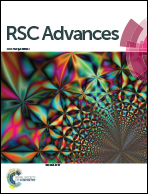Spin-canting magnetization in 3D metal organic frameworks based on strip-shaped Δ-chains†
Abstract
Three isostructural coordination polymers, M2(TZI)(OH)(H2O)2·xH2O (x = 3, M = Cu(II) 1, x = 4, M = Co(II) 2 and Ni(II) 3) (H3TZI = 5-(1H-tetrazol-5-yl)isophthalic acid), have been synthesized under hydrothermal conditions. The compounds consist of 3D frameworks, in which the magnetic Δ-chain motifs based on corner-sharing M3(μ3-OH) isosceles triangle are linked by the TZI ligands, and they represent the rare (3,4,5,6)-connected 4-nodal net topology with the point symbol (43)(4462)(4664)(4768). Magnetic analyses indicate that compound 1 shows the coexistence of spin canting, metamagnetism and antiferromagnetic ordering, whereas compounds 2 and 3 exhibit canted antiferromagnetic coupling without magnetic ordering down to 2 K. Such magnetic behaviors above 2 K are still rare in Cu(II), Co(II) and Ni(II) compounds with similar chains.


 Please wait while we load your content...
Please wait while we load your content...